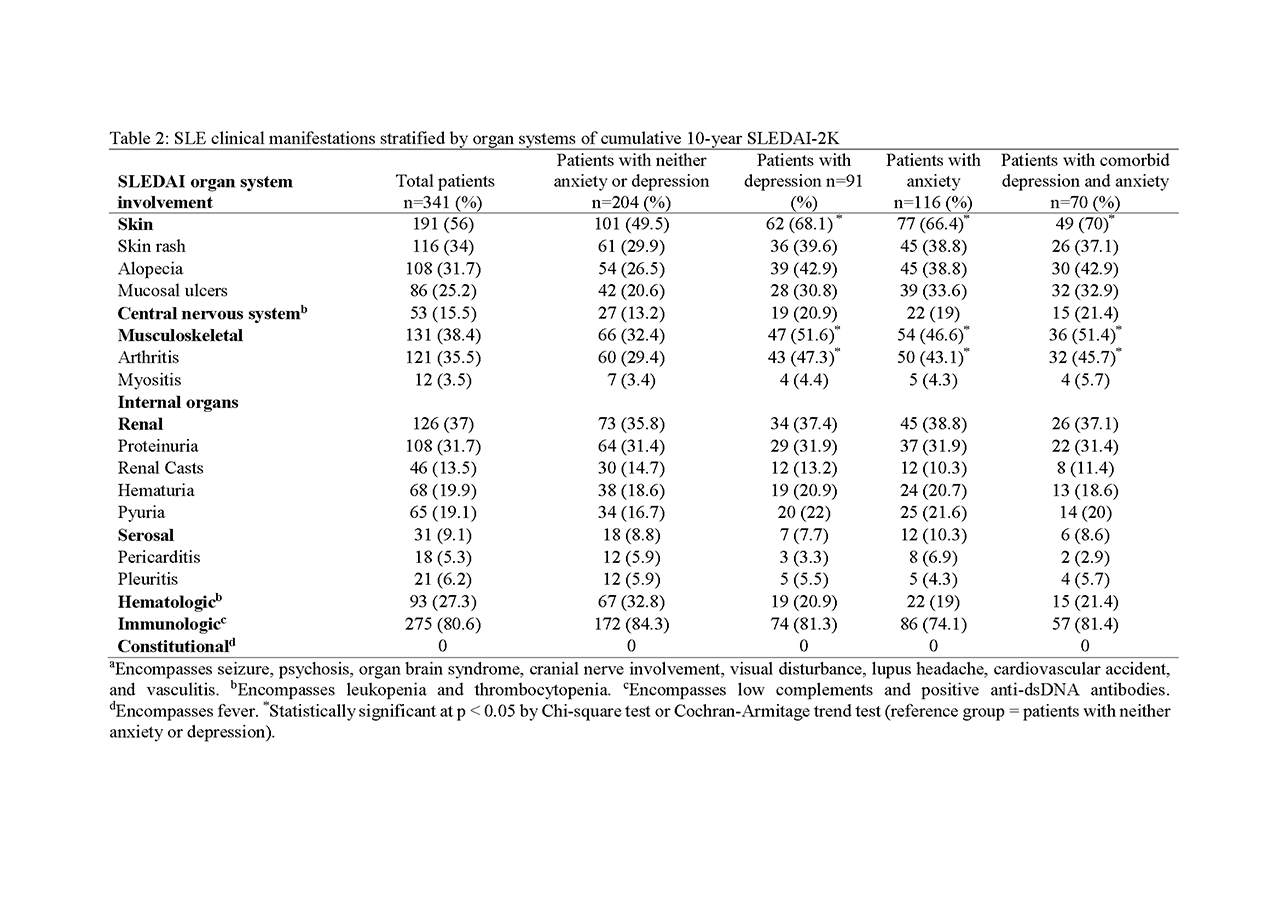Session Information
Session Type: Poster Session (Monday)
Session Time: 9:00AM-11:00AM
Background/Purpose: In our recent systematic review, we have shown a high prevalence for depression (35%) and anxiety (25.8%) in Systemic Lupus Erythematosus (SLE)1. A better understanding of the SLE phenotypic manifestations associated with depression and anxiety may lead to enhanced early diagnosis and treatment strategies.
Objectives: To determine the overall prevalence of anxiety and depression in a cohort of SLE patients, stratified by SLE-implicated organ systems and to study their associations.
Methods: Patients attending the Toronto Lupus Clinic from August 2017 to January 2019 were studied. Depression and Anxiety were diagnosed with Center for Epidemiological Studies-Depression Scale (cut-off26), BECK Depression Inventory-II (cut-off18), and the BECK Anxiety Inventory (cut-off19). Disease activity was measured with the SLE Disease Activity Index 2000 (SLEDAI-2K). The SLE phenotypic manifestations were stratified based on the organ systems of cumulative 10-year SLEDAI-2K – skin, musculoskeletal (MSK), ocular, neuropsychiatric, and internal organ manifestations (renal, pulmonary, immunologic, and haematologic). Separate multivariate logistic regression analyses (for depression [D], anxiety [A], and comorbid anxiety and depression [AD]) were performed to study the factors associated factors, including age at enrollment, sex, ethnicity, disease duration, inception status (enrolled in the clinic within 1 year of SLE diagnosis), fibromyalgia, and SLE phenotypic manifestations, comparing their significance to the group with neither A or D.
Results: 341 patients (89.7% female), with mean age 45.917.8 years were studied. The prevalence of A and D in the cohort was 34% and 27% respectively, while 21% of the total cohort was found to have AD. Among the 3 outcome groups, MSK system involvement has a significantly higher prevalence when compared to the group with neither A or D (p-values< 0.05). Skin system involvement was also significantly more prevalent among A, D, and AD groups, in comparison to the normal group. Patients with A had significantly higher odds of skin system involvement compared to the normal group (OR=1.8; 95% CI: 1.1, 3.0). Patients with D had higher odds of MSK (OR=1.9; 95% CI: 1.1, 3.5) and skin system involvement (OR=1.8; 95% CI: 1.04, 3.2) compared to the group with neither A or D. Additionally, the odds of skin system involvement was significantly higher among patients with AD, compared to the group with neither (OR=2.0, 95% CI: 1.2, 3.9). In all three models, employment and fibromyalgia were also significant. Age at enrolment was significant in the D and AD models, while inception patient status was significant in the D model exclusively.
Conclusion: SLE phenotypic manifestation, specifically those involving patients’ skin or MSK systems, along with fibromyalgia, socio-demographic factors, and inception status were associated with anxiety or depression. Routine patient screening and evaluation, especially among patients with shorter disease duration, for these associated factors may facilitate the diagnosis of these mental health disorders, and allow for more timely diagnosis and intervention strategies.
To cite this abstract in AMA style:
Eldeiry D, Zandy M, Tayer-Shifman O, Kwan A, Marzouk S, Su J, Bingham K, Touma Z. Clinical and Sociodemographic Associates of Depression and Anxiety in Systemic Lupus Erythematosus [abstract]. Arthritis Rheumatol. 2019; 71 (suppl 10). https://acrabstracts.org/abstract/clinical-and-sociodemographic-associates-of-depression-and-anxiety-in-systemic-lupus-erythematosus/. Accessed .« Back to 2019 ACR/ARP Annual Meeting
ACR Meeting Abstracts - https://acrabstracts.org/abstract/clinical-and-sociodemographic-associates-of-depression-and-anxiety-in-systemic-lupus-erythematosus/


